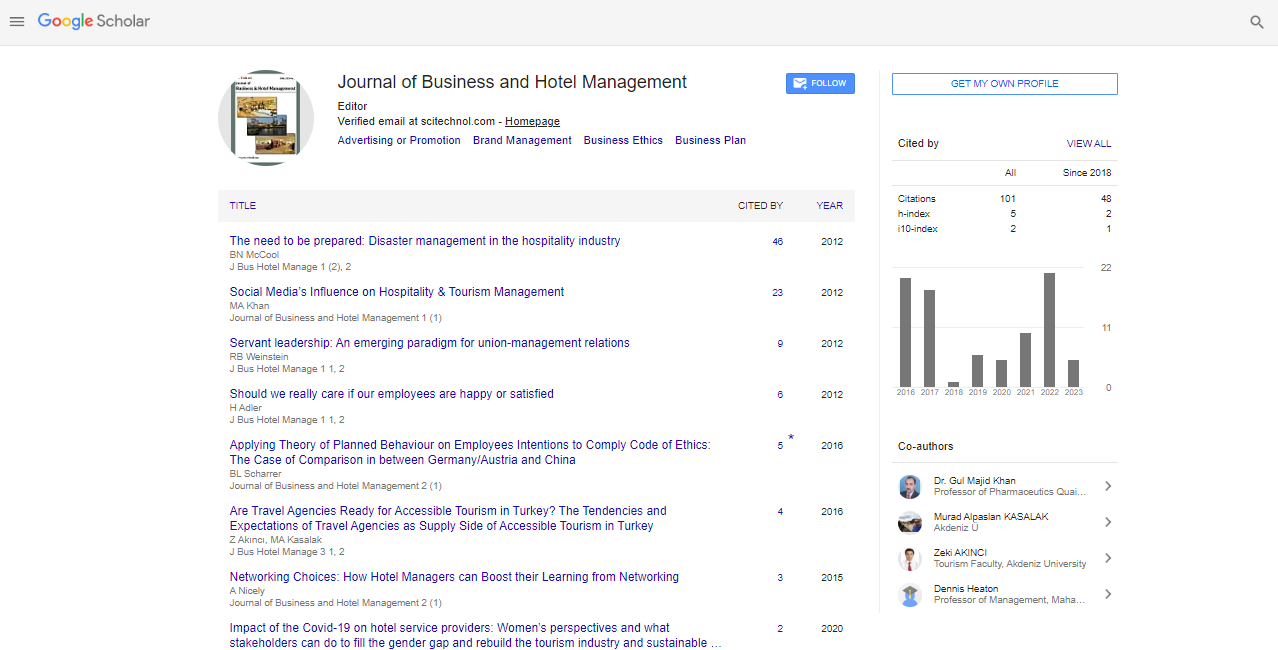Perspective, J Bhm Vol: 9 Issue: 1
Contemporary Marketing Challenges and New Methods
Dario Herhausen*
1Department of International Marketing, University of Vienna, Oskar-Morgenstern Platz 1, Vienna, Austria
*Corresponding Author: Dario Herhausen
Department of International Marketing,
University of Vienna, Oskar-Morgenstern Platz 1, Vienna, Austria
E-mail: darioherhau@univie.ac.at
Received date: 03 February, 2023, Manuscript No. JBHM-23-96113;
Editor assigned date: 07 February, 2023, PreQC No. JBHM-23-96113 (PQ);
Reviewed date: 21 February, 2023, QC No. JBHM-23-96113;
Revised date: 28 February, 2023, Manuscript No. JBHM-23-96113 (R);
Published date: 07 March, 2023, DOI: 10.4172/2324-9129.9.1.132
Citation: Herhausen D (2023) Contemporary Marketing Challenges and New Methods. J BHM 9:1.
Description
In today's fast-paced business landscape, marketers face challenges in understanding consumer needs, outpacing competitors and achieving success. New methods are important in gaining insights and making informed decisions in a manner of doing analysis on each and every aspect of marketing.
Shifting consumer behavior and preferences
Marketers must adapt to changing consumer behavior and preferences due to factors like technology, culture and economy, to effectively target and engage customers. Contemporary marketing challenges include addressing these changes for successful customer engagement.
Fragmented customer base: As marketing becomes more digital and personalized, understanding diverse customer segments and tailoring strategies is essential.
Evolving purchase journey: The customer journey is evolving and marketers must adjust their analytical techniques to account for the complexity and comprehend the full customer journey.
Rising expectations: Meeting customers' heightened expectations requires analysis to identify their preferences and develop strategies for superior product quality, customer service and personalized experiences.
Methods for shifting consumer behaviours
Big data analytics: Big data analytics is transforming marketing methods by leveraging vast data sets from diverse sources to reveal patterns and insights that inform marketing strategies and tactics.
Social listening: Social media has become a powerful tool for consumer expression and social listening provides valuable insights into consumer behavior and preferences through monitoring and analysis of social media conversations.
Online surveys and polls: Online surveys and polls are costeffective and efficient methods for gathering data from a large sample size quickly, providing valuable insights for marketing decisionmaking through feedback, opinions and preferences from consumers.
Increased competition and market saturation
Marketers face challenges in understanding the competitive landscape, identifying market gaps and positioning their brands effectively in the global business landscape that is becoming increasingly competitive, with businesses vying for market share in saturated markets. Some of the contemporary marketing challenges related to competition and market saturation include:
Intense competition: Marketers need to conduct analysis in order to understand the competitive landscape, including competitor strategies, market share and customer preferences, as businesses face competition from local and global players, leading to intense competition in the market.
Market saturation: Marketers need to identify market gaps and opportunities through analysis, to differentiate their offerings and gain a competitive edge, as many markets are reaching saturation points with multiple players offering similar products or services.
Dynamic competitive strategies: Marketers need to conduct analysis in order to understand competitor strategies, tactics and positioning to respond effectively, as competitors can quickly adapt and change their strategies, requiring constant monitoring and analysis of their moves.
Methods for increased competion
Competitive intelligence: Competitive intelligence, which involves gathering and analyzing data on competitors, including their strategies, strengths, weaknesses and market share, can help marketers gain insights into competitor moves and make informed decisions about their own strategies.
Ethnographic analysis: Ethnographic analysis allows marketers to gain deep insights into consumer behavior and preferences by observing and understanding consumers in their natural environment. This analysis can help identify unmet needs and uncover new opportunities for marketing strategies by immersing marketers in the consumer's environment and understanding their behaviors, motivations and pain points in real-world contexts.
Virtual Reality (VR) and Augmented Reality (AR): VR and AR technologies are used in marketing analysis is done to simulate realworld experiences for consumers, allowing marketers to study consumer behaviors and preferences in a controlled and immersive setting, providing valuable insights for marketing strategies and tactics.
Rapid technological advancements
Technological advancements are reshaping the marketing landscape, creating opportunities and challenges that require marketers to stay updated and adapt their new analysis to harness their potential, including addressing challenges related to emerging technologies.
Data privacy and security: Data privacy and security have become significant challenges in the era of data-driven marketing and marketers need to conduct an analysis while adhering to data protection regulations and maintaining consumer trust.
Artificial Intelligence (AI) and automation: AI and automation technologies are transforming marketing analysis, including data collection, analysis and interpretation and marketers need to understand and leverage these technologies to enhance the efficiency and effectiveness of their analysis.
Digital disruption: Digital disruption is transforming business operations, requiring marketers to adapt analysis to capture digital consumer behaviors and preferences and explore new techniques and tools beyond traditional methods to stay relevant in the digital era.
Methods for rapid technological advancements
Machine learning and predictive analytics: Machine learning and predictive analytics in marketing analysis which enables the datadriven decision-making by analyzing large datasets, uncovering patterns and making predictions about consumer behaviors, preferences and trends.
Social media analytics: Social media analytics involves advanced tools that analyze social media data for real-time insights into consumer opinions, preferences and trends, informing marketing strategies and campaigns.
Mobile analysis: Mobile analysis, such as mobile surveys, ethnography and app-based data collection, are gaining popularity as they allow marketers to capture real-time and location-based data for insights into consumer behaviors and preferences in the mobile-driven era.
Conclusion
In this dynamic marketing landscape, businesses face contemporary challenges that require innovative analysis. Marketers need to understand shifting consumer behaviors, navigate increased competition and adapt to rapid technological advancements, utilizing methods such as big data analytics, social listening, ethnographic analysis, neuro-marketing, virtual reality, augmented reality, machine learning, social media analytics and mobile analysis for data-driven decision-making.
 Spanish
Spanish  Chinese
Chinese  Russian
Russian  German
German  French
French  Japanese
Japanese  Portuguese
Portuguese  Hindi
Hindi 